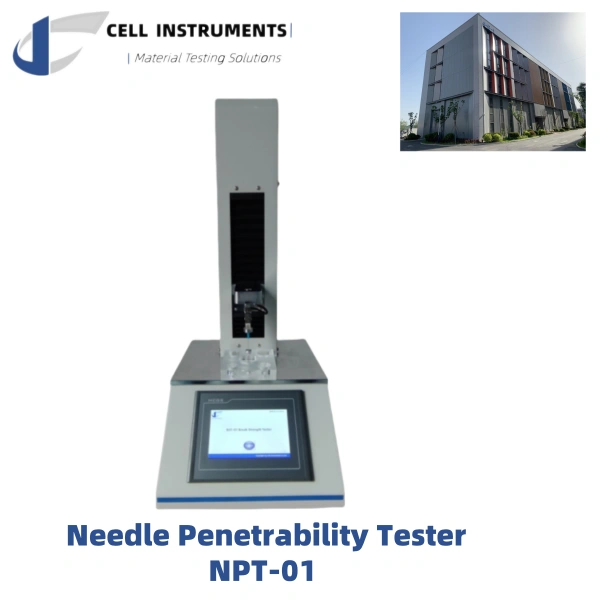How to Perform Penetrability Tests for Elastomeric Closures According to ISO 8871-5 and USP 381
The penetrability test for elastomeric closure plays a vital role in pharmaceutical packaging validation. Elastomeric closures—such as rubber stoppers used in ampoules and vials—must allow for easy needle penetration while maintaining sealing integrity. In this article, we explore how to perform the penetrability test in accordance with ISO 8871-5 and USP 381, focusing on the critical requirements, methodology, and tools needed for precise and reliable testing.
Ampoule Rubber Stopper Test and Its Importance in Pharmaceutical Quality Control
The ampoule rubber stopper test is one of several functional tests required to evaluate elastomeric closures used in injectable packaging systems. When a hypodermic needle punctures a rubber closure, several performance parameters must be validated:
- Penetrability: Measures the force required to pierce the closure.
- Fragmentation: Assesses whether rubber particles are generated during needle insertion.
- Self-sealing: Evaluates whether the closure can reseal after needle withdrawal.
Among these, penetrability is fundamental. If excessive force is needed, it may hinder medical personnel during drug administration or damage the closure, compromising sterility.
Regulatory Background: ISO 8871-5 and USP 381 Overview
ISO 8871-5: Functional Testing of Elastomeric Closures
This international standard specifies functional testing methods for closures used in parenteral packaging. Annex A outlines the method for penetrability testing:
- Requirement: Maximum piercing force must not exceed 10 N per closure.
- Equipment: Force-measuring system with ±0.25 N accuracy, compatible vials and closures, long-bevel hypodermic needles (per ISO 7864), and crimping tools.
USP 381: Elastomeric Closure Quality
USP 381 also includes penetrability as a criterion for evaluating closure functionality. Although test details may vary slightly, both standards share the objective: ensuring closure integrity while maintaining usability.
Step-by-Step Guide: How to Conduct the Penetrability Test for Elastomeric Closure
To ensure repeatable and standard-compliant results, follow these procedures:
Sample Preparation
- Use 10 closures and 10 matching vials (typically ISO 8362-1 or ISO 8362-4 compliant).
- Crimp closures using aluminium seals as per ISO 8362-3 or 8362-6.
- Ensure closures are lubricated and needle-ready.
Testing Apparatus
- Use a hypodermic needle (0.8 mm external diameter, long bevel with an 11±2° angle).
- The testing system must record force with ±0.25 N precision, up to at least 10 N.
- A vertical force application mechanism is essential to eliminate angular deviation.
Test Execution
- Mount the crimped vial in the test fixture.
- Attach a new hypodermic needle to the test probe.
- Insert the needle perpendicularly through the closure and record the maximum penetration force.
- Repeat for each of the 10 samples using a new needle.
Result Interpretation
- All force values must be ≤10 N.
- If any closure exceeds this limit, the batch may be considered non-compliant.
Why Use Cell Instruments’ NPT-01 Needle Penetrability Tester?
For laboratories and pharmaceutical manufacturers seeking high precision and reliable compliance, the Cell Instruments NPT-01 is the ideal solution for conducting penetrability tests for elastomeric closures. Key advantages include:
- Fully automated test sequences to reduce operator error.
- Real-time force-displacement curve display for in-depth analysis.
- Custom fixtures to support various vial and closure sizes.
- Compliance with ISO 8871-5, USP 381, and ISO 7864.
Whether you’re testing vial rubber stoppers, ampoule closures, or other elastomeric components, NPT-01 enhances testing efficiency and repeatability.
Tips for Ensuring Accurate Results in Penetrability Testing
- Use fresh needles for each test to avoid dull tip interference.
- Calibrate equipment regularly to maintain measurement precision.
- Avoid lateral force during needle insertion.
- Document and validate results per GMP requirements.
By following best practices and using a reliable instrument, you ensure both regulatory compliance and product safety.
Conclusion
The penetrability test for elastomeric closure is a fundamental part of pharmaceutical packaging validation, ensuring drug container systems are safe and usable. By aligning with ISO 8871-5 and USP 381, and utilizing precision tools like the Cell Instruments NPT-01, you can execute tests that meet stringent regulatory requirements while ensuring consistent, repeatable results.

